
Science in the arcade? Game on!
Science & math learning opportunities can be found in the most unlikely places! Over the weekend I took my kids to a classic amusement arcade for a bit of fun and couldn’t help but notice how the games could be used as analogies for the wider world. Amongst the predictable driving games and shoot ’em ups you can still find some old favourites that can illustrate some concepts in your classroom, you just have to aim the lesson at the right level:
Hover Hockey
Hover hockey is that classic game where a hockey puck is suspended over an air cushion so you can hit it around the table at serious speeds in order to score a goal against your opponent. All sorts of physics concepts can be raised in this game: velocity, acceleration, fiction, Newtonian forces and more. Apart from looking at motion, you can bring up the idea that the puck could represent light reflecting off a mirror – you could have students measure the angle of incidence vs the angle of reflection off the table walls and compare that to what occurs to a light beam off a reflective surface.
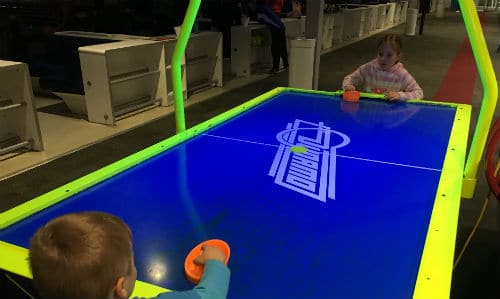
Skeeball
Roll the ball up the ramp and try to score the highest points! This game has been around for years and can be very popular for young and old students alike. As per the hover hockey game, you can use the game as an analogy for many of motion concepts however as this game also introduces a launch ramp you can discuss the physics of stunt car jumping. To able to launch a car off a ramp and have it land safely on another ramp requires careful calculations of car velocity and weight as well as the launch angle of the ramp and subsequently the landing ramp as well. Back in science class you could set up some stunt car experiments using matchbox cars and start playing around with the variables to create a successful jump.
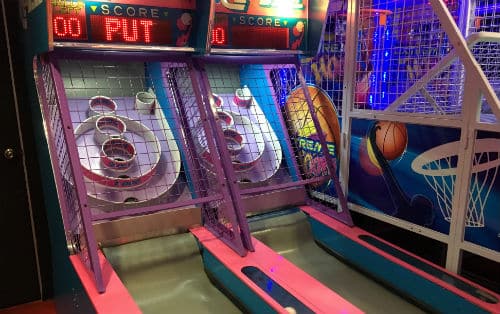
Ball drop game
Push the button at the right time to get the ball drop into the hole with the most points! Sounds easy right? Not quite, those holes are spinning too. You’ve got a few things going against you: your reaction speed, the time for the mechanics to release the ball after you pressed the button, the parallax error introduced from viewing angle not being directly above the pipe, predicting the rotating platform speed and more. Even chaos theory begins to play a part with this game as slight imperfections on the playing surface can influence the final result. This is a chance for students to identify variables in the game plus the points gained in each game can be used as data in a statistics class.
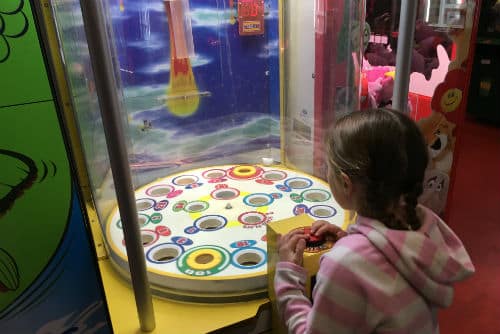
Whack ’em!
This game tests the reaction speed and coordination of the player to quickly hit the objects rising up at random intervals. The scores attained are effectively a measurement of students observation skills and hand-eye coordination skills, which makes this a simple but fun way to introduce reaction speeds when discussing the nervous system. It can be somewhat controversial though, as it can raise ethical questions around games that teach children to effectively hit animals.

It comes down to it that you can find many opportunities to teach science in areas where students are interested. Many readers who have done a high school physics course might remember being taken to as roller coaster park to study motion. With all the rapid acceleration, deceleration, spinning and more its a perfect opportunity to use science apps that take advantage of a smart phone’s accelerometer to record the forces that students are subjected to for analysis later.
Why not take this idea even further? We ran a professional development session to QLD lab technicians and teachers last year where we jumped around inside bouncing castles and wrestled in giant Sumo suits to exactly that! The teachers absolutely loved it and you’d be hard pressed to find a student who wouldn’t want to collect the data in your own lesson.
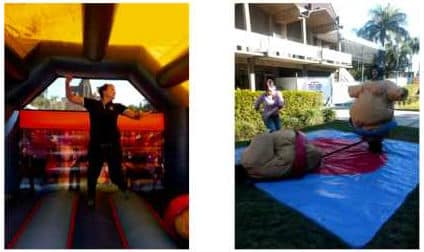
Holly bouncing around in the name of science 🙂
Even if you don’t have the budget for taking students to a roller coaster park or hiring a jumping castle you could simply use the same idea in a smaller scale using skateboards or even using the sports equipment to set up hurdles, discus, high jump or long jump… just make sure the smartphone is safely secured in a zipped up jacket pocket or similar. You can also have one of our scientists visit your school to discuss forces & movement in a variety of toys and games which can be a lot of fun too!
So, next time you’re struggling for ideas to engage your students maybe have a look at what is grabbing their fancy. If it moves there are some physics and maths there somewhere 🙂
Happy teaching,
NEW Primary science teaching book!
“Be Amazing! How to teach science, the way primary kids love”

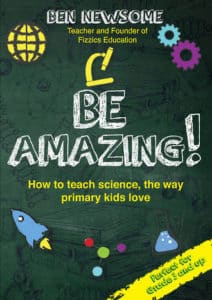

























Impressive! This is very helpful tips and strategies. How about a booklet, or guide for teachers not limiting to STEM but across curriculum — that is generic to all.
Glad that you’ve found these resources useful George!
As science educators we have produced a book ‘Be Amazing – How to teach science the way primary kids love’ which whilst has a very strong STEM focus, it has a variety of teaching techniques that is applicable for all key learning areas. You can get this on Amazon here. You can also subscribe to our newsletter where we regularly post articles on ideation, classroom management, teaching ideas and more. You can subscribe here.
All the best, thanks for reading!